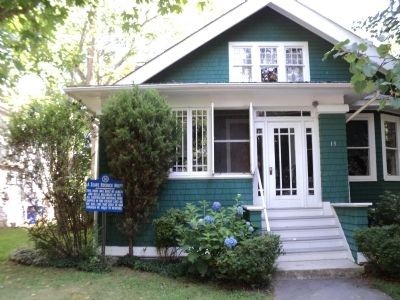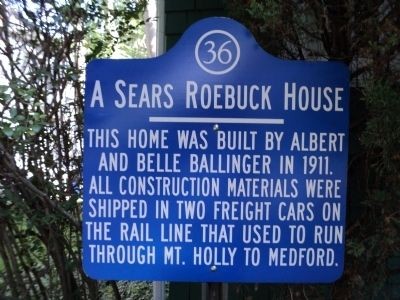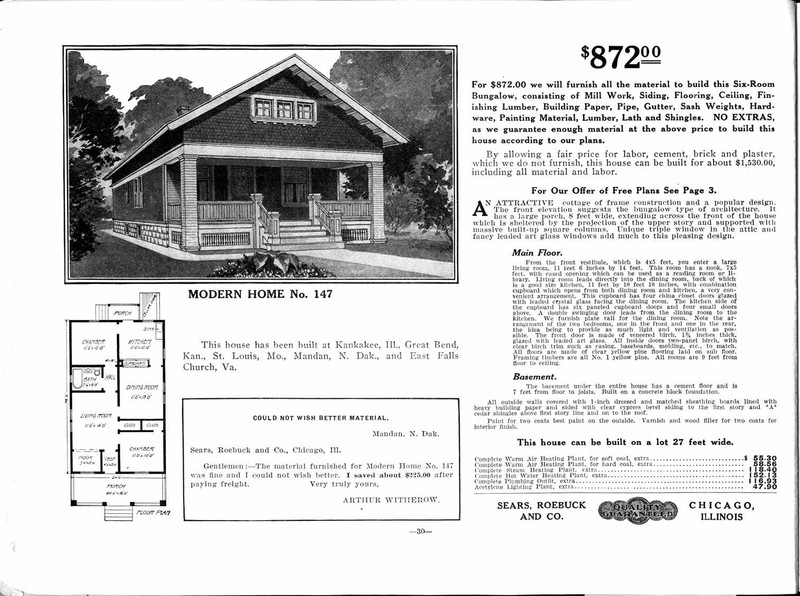A Sears Roebuck House and Historical Marker
Introduction
Text-to-speech Audio
Images
Photograph of the Sears Roebuck House and historical marker in front.

Photograph of the Sears Roebuck House historical marker.

Image of a Sears Home kit that looks similar to the home at 13 Branch Street. Renovations may have been made since its construction in 1911.

Backstory and Context
Text-to-speech Audio
From 1908-1940, Sears, Roebuck & Co. offered construction kits for a variety of homes. Between 70,000 and 75,000 mail-order homes were purchased in 447 designs. For a flat price, Sears, Roebuck & Co. furnished all the construction materials for the purchased home. The kits, for instance, consisted of mill work, siding, flooring, pipes, gutters, hardware, painting materials, lumber, and shingles. Labor is not included, but Sears, Roebuck & Co. provided an estimate of how much a home would cost for materials and labor. Despite offering flat prices for popular home designs, customers could modify the designs of their homes or submit blueprints to Sears, Roebuck & Co. to receive pre-cut materials for the home.
To purchase a home, customers would receive a Modern Homes catalog. Despite showing home styles that customers were familiar with, customers could customize the home. For instance, a customer could reverse the floor plan or choose brick instead of wooden siding. Modern Homes were so customizable that customers could choose the color of the hardware on cabinets. In addition to customization, customers also had modern conveniences, like central heating, indoor plumbing, and electricity.
Modern Homes by Sears were cheaper because Sears could mass-produce materials, which lowered purchasing costs for customers. Pre-cut materials meant that construction time was 40% faster than alternative methods. The "ballon style" framing of the homes also meant that a team of skilled carpenters were not needed to built the home.
This Sears Roebuck home was built in 1911 by Albert and Belle Ballinger at 13 Branch Street in Medford, New Jersey. A home kit similar to the one at 13 Branch Street in Medford, New Jersey, has the following description:
An attractive cottage of frame construction and a popular design. The front elevation suggests the bungalow type of architecture. It has a large porch, 8 feet wide, extending across the front of the house which is sheltered by the projection of the upper story and supported with massive built-up square columns. Unique triple window in the attic and fancy leaded art glass windows add much to this pleasing design.
Modern Homes by Sears meant that customers could quickly build custom homes with modern conveniences and technologies.
Sources
Coughlin, Bill. A Sears Roebuck House, The Historical Marker Database. June 16th 2016. Accessed January 4th 2020. https://www.hmdb.org/m.asp?m=44718.
Sears Homes 1908-1914, Sears Archive. March 21st 2012. Accessed January 4th 2020. http://www.searsarchives.com/homes/1908-1914.htm.
What is a Sears Modern Home?, Sears Archive. March 21st 2012. Accessed January 4th 2020. http://www.searsarchives.com/homes/index.htm.
Image courtesy of Bill Coughlin at the Historical Marker Database.
Image courtesy of Bill Coughlin at the Historical Marker Database.
Image courtesy of Sears Archives.
